Reply 60 of 74, by ragefury32
Standard Def Steve wrote on 2021-01-05, 22:13:ragefury32 wrote on 2021-01-02, 20:23:Standard Def Steve wrote on 2021-01-02, 18:56:Jeez, did the Powerbooks actually use 60x right up until the Intel switch? That's terribad if true. I used to own a 17" G4 and always thought that it felt a little sluggish in Leopard, despite having a 9700 Pro. The CPU being stuck on the 60x bus would definitely explain it.
IIRC on the desktop side, the Yikes/PCI G4 was the last machine to use 60x; all of the AGP machines used the much faster MPX bus.
Whoops - I confused the 60x with the MPx. The Aluminum PowerBooks all use the Intrepid/KeyLargo setup, so they are 133MHz FSB machines with DDR RAM. Even with the MPx they are not exactly keeping up with the 266MHz FSB on the Athlon Bartons, much less the 400/533/800 MHz on the Netburst/Pentium-M - at that stage it’s like trying to bring a Tualatin to 2005 - it’s got some good points but definitely showing its age.
Yeah, Pentium M was probably the chip that convinced Apple to finally ditch PPC. I mean, in 2005 you could pick up a cheap Dothan-equipped Inspiron that would run circles around a $2500 Powerbook G4 while using less power. It was definitely not a good look for Apple.
Adding some L3 cache to the Powerbooks would've helped alleviate some of the memory bandwidth deficit without sucking down too much extra juice. There were quite a few instances where the giant 2MB L3 in the PowerMacs really helped with CPU performance, so I'm still kinda surprised that Apple didn't go that route with the high end 15" and 17" Powerbooks. But hey - at least they didn't further starve the G4 of memory bandwidth with integrated video!
Well, yes and no. Apple started looking at Intel when Motorola cancelled the PowerPC 7500 chip, the mythical 64 bit non-IBM PowerPC G5 project that started in 1999 and died in 2001. It was supposed to be the next great chip that was to underpin Apple’s next big growth spurt, but it didn’t work out. Supposedly the chip was never fully synthesized and IBM had to cut the POWER4 server chip down to meet Apple’s needs for a G4 successor. IBM didn’t have a suitable northbridge for Apple to use in the PowerBooks, the chip was never really designed to sip power, and at the same TDP/energy envelope needed for a PowerBook it was only about as fast as the Apollo8 G4s, so there’s no roadmap for growth from the AIM alliance. Both IBM and Motorola were using PowerPC for embedded applications (IBM did well fabbing PowerPC “little bro” variants for Nintendo/Sony/Microsoft and selling POWER “big bro” servers to its business customers, Motorola (soon Freescale) were tossing G4 chips into high end network switchgear). No one was really interested to make high cadence silicon chips for a brash little Silicon Valley computing firm constantly asking for faster chips.
The Pentium M was this side project Intel had in its Haifa design center in Israel that was not really meant to be the future of the company. It was originally supposed to be the foundation of a cheap, highly integrated x86 chip (Timna) with RDRAM for high volume low price PCs - think Atom before Atom and with a P6 core. The difficulty the Israeli team dealt with were high latency on the RDRAM so they had to spend serious effort making the P6 core work with the architecture - that involved maximizing L2 cache usage. The Timna project was later cancelled because RDRAM prices never came down enough for the low cost PC to work.
The performance of the original run of Norwood P4ms made Intel afraid of losing the Mobile market to Transmeta and Athlon XP-ms (the Thoroughbred/Barton cores were excellent performers and rather efficient too), which is why they told the Israeli engineers to take the P6 core, shrink it down, give it the Netburst FSB, better power management, take whatever they learn with getting Timna going, and to make it work. That’s how Banias came to being with its 1MB of L2 cache, and how it gave the Pentium 4s a real run for its money.
Side note - more than a few of the engineers on the Pentium-M project team in Israel ended up going to PASemi - PASemi was originally a PowerPC licensee that was supposed to present Apple with a better PowerPC chip (PWRficient) to be fabricated by TI - they didn’t (it happened right at the eve of the Intel transition) - Apple ended up working with them on a few embedded projects (iPod, iPhone, etc) and eventually bought them out. They are now the core of Apple’s in-house silicon design firm.





